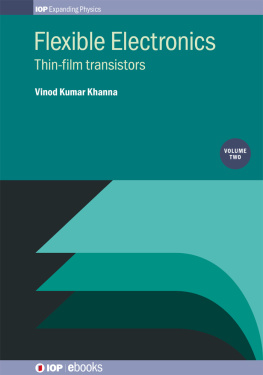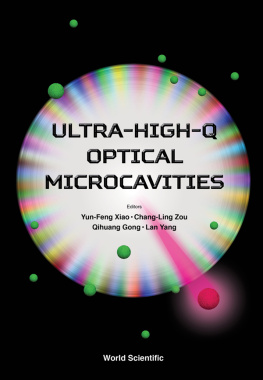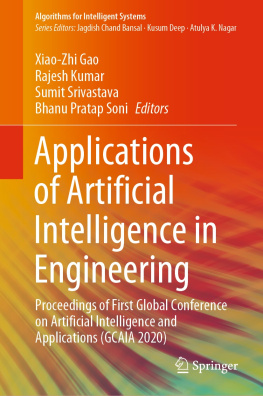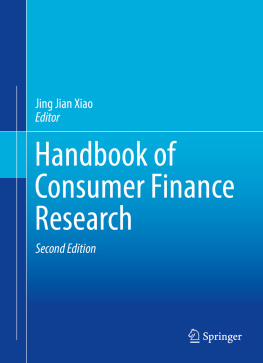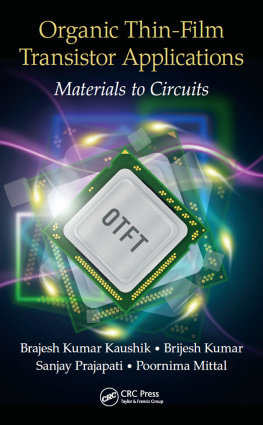Yang Xiao-Yu - Photoenergy and Thin Film Materials
Here you can read online Yang Xiao-Yu - Photoenergy and Thin Film Materials full text of the book (entire story) in english for free. Download pdf and epub, get meaning, cover and reviews about this ebook. year: 2019, publisher: John Wiley & Sons, Incorporated, genre: Home and family. Description of the work, (preface) as well as reviews are available. Best literature library LitArk.com created for fans of good reading and offers a wide selection of genres:
Romance novel
Science fiction
Adventure
Detective
Science
History
Home and family
Prose
Art
Politics
Computer
Non-fiction
Religion
Business
Children
Humor
Choose a favorite category and find really read worthwhile books. Enjoy immersion in the world of imagination, feel the emotions of the characters or learn something new for yourself, make an fascinating discovery.
- Book:Photoenergy and Thin Film Materials
- Author:
- Publisher:John Wiley & Sons, Incorporated
- Genre:
- Year:2019
- Rating:5 / 5
- Favourites:Add to favourites
- Your mark:
- 100
- 1
- 2
- 3
- 4
- 5
Photoenergy and Thin Film Materials: summary, description and annotation
We offer to read an annotation, description, summary or preface (depends on what the author of the book "Photoenergy and Thin Film Materials" wrote himself). If you haven't found the necessary information about the book — write in the comments, we will try to find it.
Photoenergy and Thin Film Materials — read online for free the complete book (whole text) full work
Below is the text of the book, divided by pages. System saving the place of the last page read, allows you to conveniently read the book "Photoenergy and Thin Film Materials" online for free, without having to search again every time where you left off. Put a bookmark, and you can go to the page where you finished reading at any time.
Font size:
Interval:
Bookmark:
Texturing, Etching, Cleaning, and Surface Preparation for Silicon Wafer Solar Cells Manufacturing
Edited by Monika Freunek Mller
Forthcoming 2020. ISBN 978-1-119-24189-8
Indoor Photovoltaics
Edited by Monika Freunek Mller
Forthcoming 2019. ISBN
Advanced Thermoelectric Materials
Edited by Chong Rae Park
Forthcoming 2019. ISBN 978-1-119-40730-0
Photoenergy and Thin Film Materials
Edited by Xiao-Yu Yang
Forthcoming 2019. ISBN 978-1-119-58046-1
Advanced Battery Materials
Edited by Chunwen Sun
Forthcoming 2019. ISBN 978-1-119-40755-3
Fundamentals of Electrocatalysts Materials and Interfacial Characterization
Energy Producing Devices and Environmental Protection
By Nicolas Alonso-Vante, Carlos Augusto Campos Roldn, Rosa de Guadalupe Gonzlez Huerta, Guadalupe Ramos Snchez and Arturo Manzo Robledo
Published 2019. ISBN 978-1-119-46007-7
Advanced Topological Insulator Materials
Edited by Huixia Luo
Published 2019. ISBN 978-1-119-40729-4
Photoelectrochemical Solar Cells
Edited by Nurdan Demirci Sankr and Mehmet Sankr
Published 2019. ISBN 978-1-119-45993-4
Emerging Photovoltaic Materials
Edited by Santosh K. Kurinec
Published 2019. ISBN 978-1-119-40754-6
Photovoltaic Modeling Handbook
Edited by Monika Freunek Mller
Published 2018. ISBN: 978-1-119-36352-1
Energy Efficient Manufacturing Theory and Applications
Edited by John W. Sutherland, David A. Dornfeld and Barbara S. Linke
Published 2018. ISBN: 978-1-118-42384-4
Printable Solar Cells
Edited by Nurdan Demirci Sankir and Mehmet Sankir
Published 2017. ISBN: 978-1-119-28371-3
An Introduction to the Physics and Electrochemistry of Semiconductor Fundamental and Applications
By Maheshwar Sharon
Published 2016. ISBN: 978-1-119-27433-9
Advanced Energy Materials
Edited by Ashutosh Tiwari and Sergiy Valyukh
Published 2014. ISBN 978-1-118-68629-4
Solar Cell Nanotechnology
Edited by Atul Tiwari, Rabah Boukherroub, and Maheshwar Sharon
Published 2014. ISBN: 978-1-118-68625-6
Handbook of Cleaning for Semiconductor Manufacturing
Fundamentals and Applications
Published 2011. ISBN: 978-0-470-62595-8
www.scrivenerpublishing.com
Use of Carbon Nanostructures in Hybrid Photovoltaic Devices
Teresa Gatti
Department of Chemical Sciences, University of Padova, Padova, Italy
This chapter provides an overview of the advantages resulting from the inclusion of carbon nanostructures (CNSs) within the different components of last-generation hybrid photovoltaic (HPV) devices. Among hybrid devices, here only dye-sensitized solar cells (DSSCs) and perovskite solar cells (PSCs) are considered. In particular, the latter have been attracting the attention of researchers for less than a decade, but are extremely promising. In this context, CNSs are employed as auxiliary materials, to boost performances and stabilities, as well as to make production costs even lower. This chapter is indeed focused on carbon nanotubes, graphene-based materials and fullerenes. After briefly recalling the configuration of DSSCs and PSCs and the structures and properties of CNSs, strategies of CNS integration within different components of devices are described. Special attention is drawn to chemical functionalization of CNSs, enabling easier processing and addressing selective interactions with other species. Then, the discussion directs towards the roles played by the different CNS species in HPV cells, highlighting in particular strategies for improving device stability. Indeed the topic recalls nowadays a large attention from the scientific community. Finally, perspectives are indicated for further improvements of performances through the inclusion of CNSs in HPV devices.
Keywords: Carbon nanostructures, hybrid photovoltaics, carbon nanotubes, graphene based materials, fullerenes, dye sensitized solar cells, perovskite solar cells
The need for stable photovoltaic (PV) devices comes along with the search for new solutions able to lower the overall costs of production of solar panels. PV devices based on single-crystal silicon are nowadays available on the market, providing power conversion efficiencies (PCEs) as high as 23% and 25 years operational lifetimes, as generally guaranteed by manufacturers [1]. Nevertheless, big efforts are addressed at developing new processes for their production ensuring higher-throughput, lower costs and better robustness.
Innovative perspectives were opened with the rise of organic PV (OPV) [2], which came into the international research focus at the beginning of the new millennium with the novel donor-acceptor bulk heterojunction (BHJ) architecture [3], and can provide today up to 13% PCE and encouraging lifetimes of more than 5000 hr for un-encapsulated devices [4]. At the same time, the combination of organic and inorganic materials allowed the development of alternative PV structures, defined from now on as hybrid PV (HPV) [5]. OPV and HPV are both part of the so-called third generation of solar devices.
Within HPV, we can distinguish two promising solutions, which couple good PCE with significant opportunities to develop low-cost, industry-scalable technologies, namely dye sensitized solar cells (DSSCs) and perovskite solar cells (PSCs). The latter are somehow a direct legacy of the former and indeed their development is mostly based on the previous knowledge built up after more than two decades of intensive research. DSSCs [6] are also named Graetzel-type solar cells, after the inventor, Michael Graetzel, from the cole Polytechnique Fdrale de Lausanne [7]. These devices feature a light-harvesting architecture based on a photosensitizer material, able to split excitons into separated charges, and a metal oxide semiconductor acting as the electron acceptor. In DSSCs, the photosensitizer is a molecular dye, often consisting of a ruthenium polypyridine complex, although this class is nowadays put aside by the development of metal-free organic dyes, allowing the elimination of expensive heavy metal components [6]. The advent of perovskite absorbers in 2009 [8], starting from hybrid methylammonium lead halides, evolving to hybrid mixed cation lead halides [9] and finally to all-inorganic perovskites [10], has significantly shifted the attention of the research community from DSSCs to PSCs. Perovskite materials are indeed characterized by outstanding light-absorption properties, high charge-carrier mobility and lifetime. This allows to produce solar cells with PCEs overcoming those of classical DSSCs by almost a 50% factor, with a current certified record of 23.3% (registered in 2018) [11].
The evolution of device architectures from classical DSSCs to solid state DSSCs (ssDSSCs) and then to mesoporous and planar PSCs is well described in ) or extends further out of the mesoporous scaffold generating a perovskite-based capping layer on which the HTM is deposited (not depicted in the figure). Good PCEs are obtained also by employing PSCs based on planar architectures, where the active perovskite layer has a thickness around 0.5 m. This happens since perovskites are able to generate and transport both electrons and holes to the collecting contacts with close to unity efficiency [12].

Historical evolution of light harvesting architectures, going from standard DSSCs based on liquid electrolytes (left) to ssDSSCs based on solid hole conductors (center-left), then to mesoporous PSCs (center-right, MSSC = meso-superstuctured solar cell) and to planar PSCs (right). The Ag cathode is often replaced by Au. Adapted from reference [12] with permission of the American Chemical Society.
Font size:
Interval:
Bookmark:
Similar books «Photoenergy and Thin Film Materials»
Look at similar books to Photoenergy and Thin Film Materials. We have selected literature similar in name and meaning in the hope of providing readers with more options to find new, interesting, not yet read works.
Discussion, reviews of the book Photoenergy and Thin Film Materials and just readers' own opinions. Leave your comments, write what you think about the work, its meaning or the main characters. Specify what exactly you liked and what you didn't like, and why you think so.




